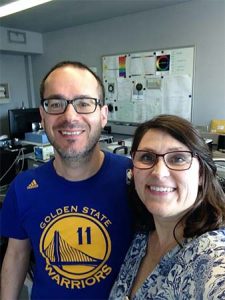The TREX team includes laboratories all over the world that are involved in the TREX spectroscopy work. These laboratories include facilities at DLR (the German Aerospace Center, Berlin), University of Winnipeg (Canada), Planetary Science Institute (Tucson, AZ), and the University of Colorado (Boulder, CO).
We are also measuring the samples using other types of data including Raman and Mössbauer. Both of these types of instruments are located at Mount Holyoke College in South Hadley, MA.
It all starts with samples! TREX will focus on terrestrial minerals, meteorites, and lunar regolith. The term terrestrial means that these minerals are Earth samples, unlike the second group of samples that are meteorites mostly from asteroids. Our third sample group is soils – regolith – from the Earth’s Moon!
A little more about the 3 groups of samples
Right now, we are wrapping up our study of about 30 different minerals. Although there are hundreds of thousands of different minerals on Earth, we had to reel in what we study. Our team is looking at about 30 of the common rock-forming minerals on Earth (because the mineral selection should cover many of the types of minerals that occur in meteorites and are present on the Moon, too!) Some of these samples (*) are being used by several SSERVI teams for cross-SSERVI collaborations.
Earth minerals come in many kinds! Here are the ones were examining:
Forsterite Globe*
Forsterite SC*
Bytownite CB*
Labradorite Chihuahua*
Labradorite ARSAA
Diopside Herschel*
Augite Harcourt*
Albite (AL-I)
Anorthite (AN-G)
Spinel ARSAA
Phlogopite Mica-Mg
Enstatite (Zen 1)
Hematite AA-30
Hematite SA-500g
Pyrite
Palygorskite (PFI-1)
CaS (oldhamite)
Hectorite (SHCa-1)
Nontronite (NAu-2)
Na-montmorillonite (SWy-3)
Ca-montmorillonite (STx-1b)
Kaolinite (KGa-1b)
Serpentine, lizardite (UB-N)
Serpentine, antigorite (SMS-16)
Ilmenite
Zinnwaldite (ZW-C)
Fe metal <10 um
Graphite 7-11 um

We are also looking at samples from a myriad of different meteorites, each of a different meteor class, from Aubrite to Urelite.
ALH 84007, Aubrite
EET 99402, Brachinite
LON 94101, CM2
MIL 090001, CR2
EET 79002, Diogenite
LAR 12001, EH3
MIL 11290, Eucrite
WSG 95300, H3.3
GRA 98186, H6
LAR 12326, Howardite
MIL 07010, L impact melt
RKP 79015, Mesosiderite
PCA 82506, Urelite
There are basically 3 types of meteorites: stony, metal, or a combination. Meteorites can further be classified according to the content of iron (Fe) or carbon (C). Some of our meteorites are high-Fe (H) and some are low-Fe (L) in composition. Other meteorites have carbonaceous material in them.
We also will study lunar materials. That’s right –- soils that have been brought back from the Moon by astronauts. Our lunar sample list has not yet been approved by the Curation and Analysis Planning Team for Extraterrestrial Materials (CAPTEM) but we will list those when we know for sure what samples we will study.
How we study them
We use a technique called spectroscopy. Basically our scientists measure how light energy interacts with the samples (reflects or emits). We are studying our samples from short wavelength ultraviolet (UV) light through visible (VIS), near infrared (NIR), and into mid-infrared (MIR) wavelengths.

What we do with the spectra
Once we have obtained the spectra, we can use them to study data returned from many spacecraft instruments (or Earth-based telescope data) to see if there are spectral similarities.
